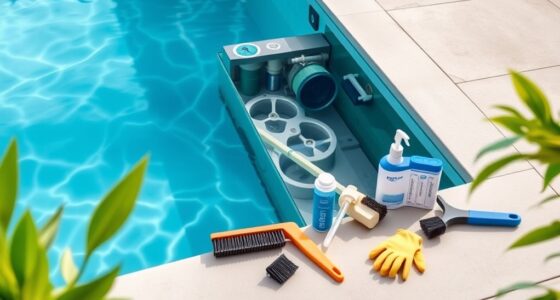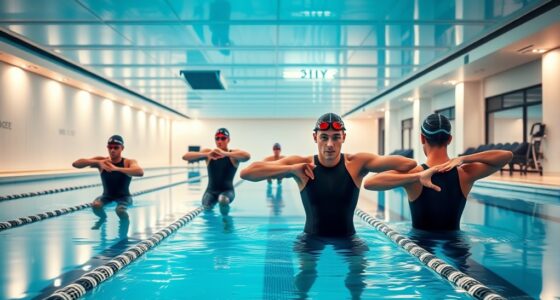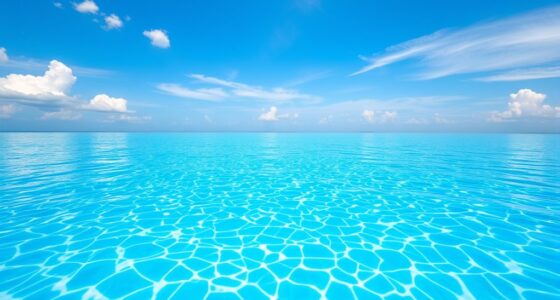To make your Endless Pool efficient and save on operating costs, focus on upgrading to energy-efficient equipment like variable speed pumps and Energy Star-certified systems. Use a well-fitting cover to keep heat in and maintain ideal temperature without overworking the heater. Schedule filtration during off-peak hours and consider smart controls or solar solutions to cut energy use further. Regular maintenance and insulation also boost efficiency. Keep exploring these tips to really maximize your pool’s energy savings.
Key Takeaways
- Use energy-efficient equipment like Energy Star-certified pumps and heaters, and maintain them regularly for optimal performance.
- Schedule filtration and heating during off-peak hours to reduce energy rates and operating costs.
- Insulate your pool and use a well-fitting cover to minimize heat loss and improve heat retention.
- Monitor energy consumption with smart controls and timers to optimize operation and identify inefficiencies.
- Consider renewable energy options such as solar panels to offset electricity use and lower long-term costs.
Understanding Your Pool’s Energy Consumption
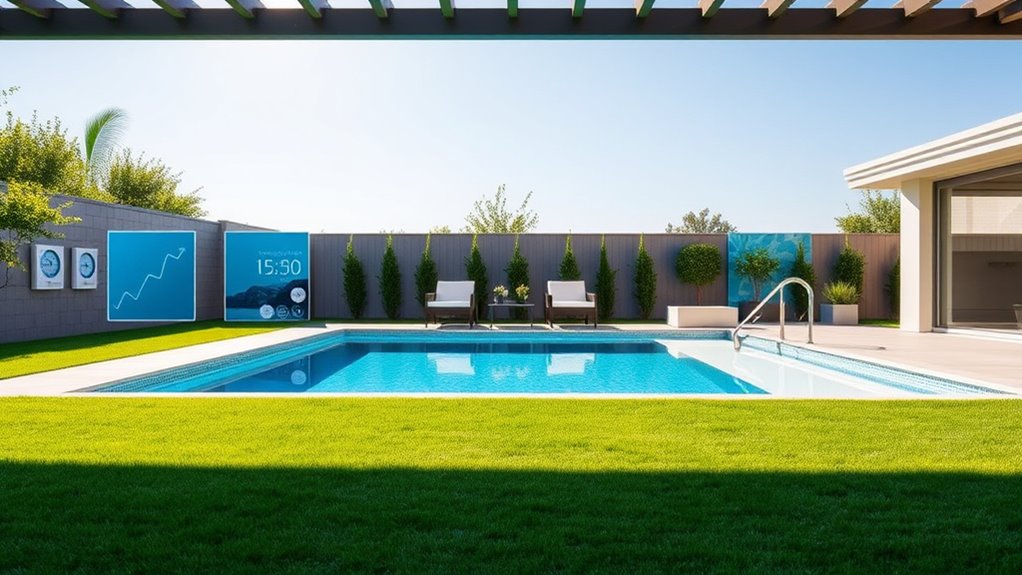
To effectively manage your pool’s energy use, it’s essential to understand how much power your equipment consumes. Start by checking the labels or manuals on your pool pump, heater, and filtration system—they usually list wattage or amperage. Use a power meter to get accurate readings of real-time energy consumption. Keep track of how long each piece of equipment runs daily, and note any patterns or peak usage times. Understanding your equipment’s energy profile helps identify areas where you might reduce power use. Remember, older or inefficient equipment tends to draw more energy, increasing your overall costs. Additionally, sound design techniques can be applied to optimize your pool’s operation, such as adjusting filtration cycles to off-peak hours, which can further reduce energy consumption. By knowing exactly how much energy your pool consumes, you can make informed decisions to optimize operation and cut unnecessary expenses.
Choosing Energy-Efficient Pumps and Motors
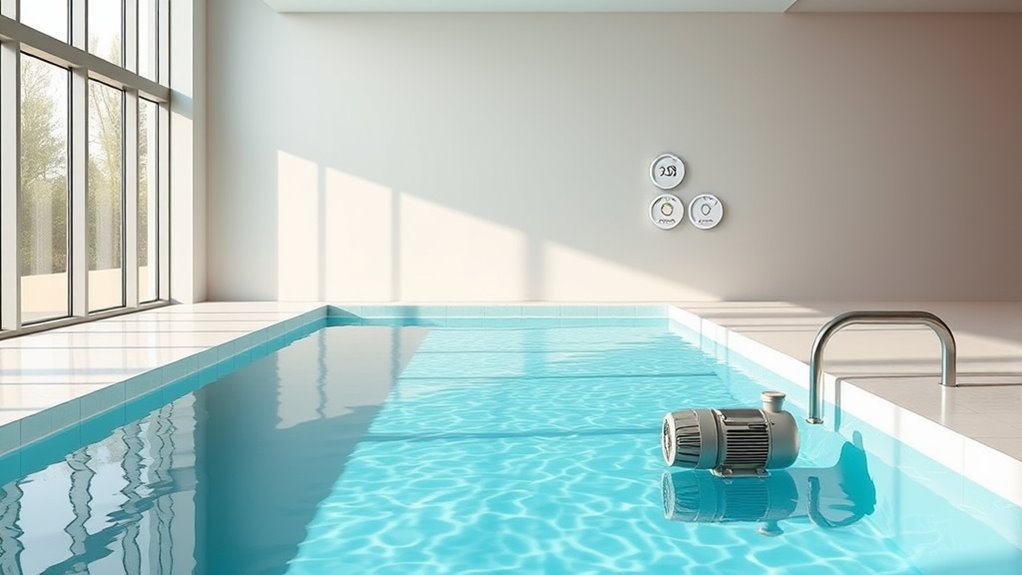
When selecting pumps and motors, look for Energy Star certifications to guarantee they’re energy efficient. Consider models with variable speed technology, which adjust power based on your needs and save energy. These choices can considerably reduce your operating costs over time.
Energy Star Certifications
Energy Star certifications play a essential role in helping you select pumps and motors that operate efficiently and save money. When a pump or motor bears this label, it meets strict energy performance standards set by the EPA. This means you’re choosing equipment that uses less electricity while maintaining ideal performance. Energy Star-certified models often have advanced features, like better insulation and improved design, which reduce energy waste. By opting for these products, you can lower your operating costs and minimize your environmental impact. Keep in mind, certification alone isn’t enough—ensure the specific pump or motor matches your pool’s requirements. Additionally, color accuracy in the components can influence overall efficiency and performance. Investing in Energy Star-certified equipment is a smart move toward a more energy-efficient and cost-effective pool operation.
Variable Speed Technology
Choosing the right pump or motor is key to optimizing energy efficiency, and Variable Speed Technology (VST) offers a powerful way to do that. With VST, your pump can adjust its speed based on your pool’s needs, rather than running at full power constantly. This means you use only the energy necessary to maintain ideal water flow and temperature, reducing waste and lowering operating costs. VST also enhances performance by providing smoother operation and quieter running. Installing a VST-enabled pump allows you to program settings for different usage patterns, optimizing efficiency during peak and off-peak times. Overall, VST helps you save energy, extend equipment lifespan, and create a more sustainable, cost-effective swimming experience.
Optimizing Pool Temperature Settings
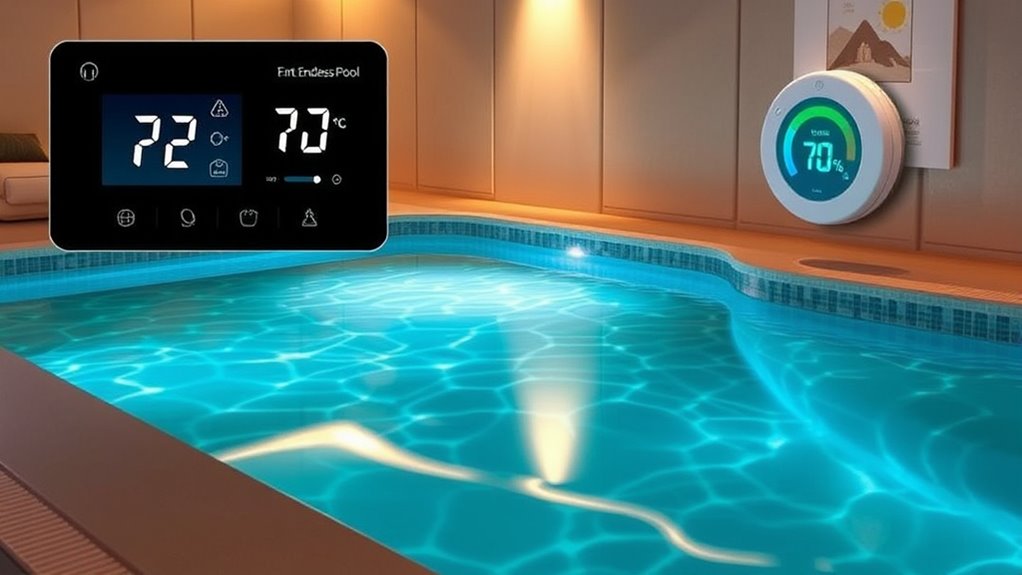
To maximize energy efficiency and reduce operating costs, setting your pool temperature to the ideal level is essential. Keeping your pool too warm wastes energy, while too cold can make swimming uncomfortable. Aim for a temperature between 78°F and 82°F for best comfort and efficiency. To fine-tune your settings, consider these steps:
- Monitor usage patterns – Adjust the temperature slightly lower during periods of infrequent use.
- Balance comfort and savings – Find a temperature that suits your swimming habits without unnecessary energy expenditure.
- Use a thermometer – Regularly check your pool’s temperature to maintain consistent and effective settings.
- Understanding the importance of fathers’ influence can help you appreciate how consistent habits and care contribute to maintaining optimal conditions for your pool’s operation.
Using a Cover to Minimize Heat Loss
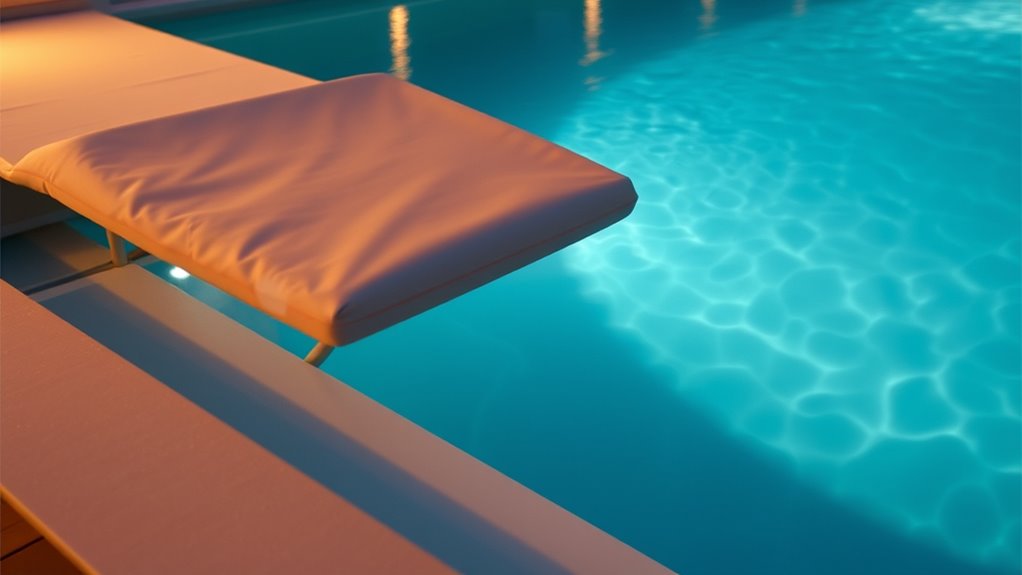
Using a cover is one of the easiest ways to trap heat and cut down on energy loss. You need to choose a cover that fits well and is designed to minimize heat escape. This simple step can considerably reduce your operating costs and keep your pool warmer for longer.
Trapping Warmth Effectively
Have you ever noticed how quickly heat escapes from a pool or hot tub overnight? To trap warmth effectively, using a cover is essential. Here’s how you can maximize its efficiency:
- Ensure the cover fits snugly without gaps to prevent heat from escaping.
- Use a cover with insulating properties to slow heat transfer.
- Keep the cover clean and dry to maintain its effectiveness.
- Select a cover made from natural materials like wood or linen to enhance insulation and durability.
Choosing the Right Cover
Choosing the right cover can considerably reduce heat loss from your pool or hot tub. A well-fitting cover creates a barrier that traps heat, preventing it from escaping into the environment. Look for covers made with insulated materials, such as foam cores, which provide better thermal retention. Make certain the cover fits snugly without gaps, as even small openings can lead to significant heat loss. Consider covers with a durable, weather-resistant exterior to withstand outdoor conditions. Using a cover during off-hours or when the pool isn’t in use can cut your energy costs substantially. Regularly maintaining and replacing your cover when it shows signs of wear helps keep heat loss minimal. Proper installation planning and choosing the right cover are simple, effective ways to improve energy efficiency and lower operating costs. Investing in the right cover is a simple, effective way to improve energy efficiency and lower operating costs.
Implementing Smart Filtration and Circulation Schedules
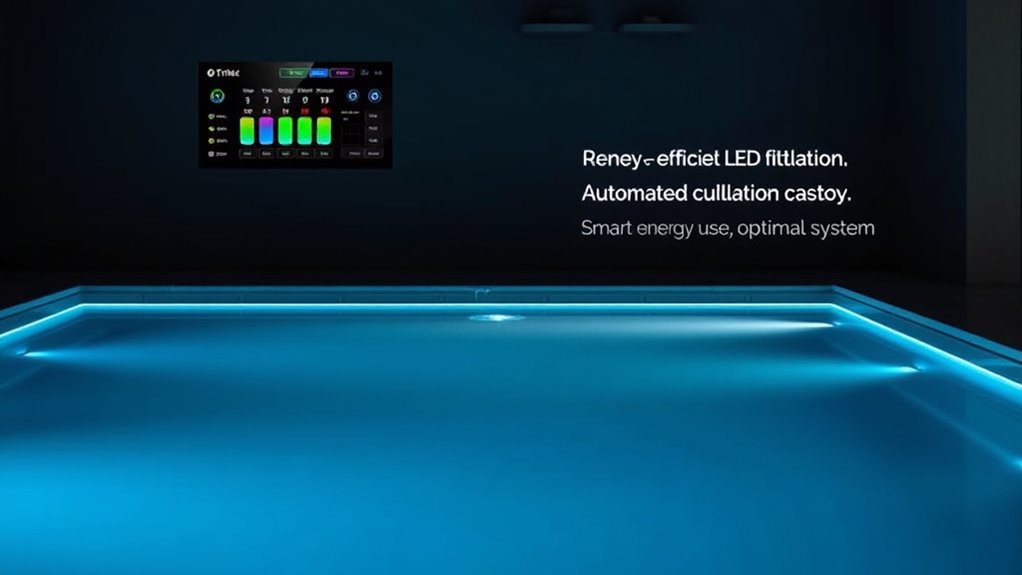
How can smart filtration and circulation schedules maximize your pool’s energy use and reduce operating costs? By tailoring your system’s operation to your usage patterns, you avoid unnecessary energy waste. Here’s how:
- Schedule filtration during off-peak hours to lower energy rates and minimize impact on your utility bill.
- Adjust circulation times based on pool activity so the pump runs only when needed, reducing wear and energy consumption.
- Use programmable timers and smart controls to automate adjustments, ensuring ideal operation without manual intervention.
- Properly maintaining your system and choosing the right tea kettle material can also improve efficiency and prolong equipment lifespan.
Implementing these strategies ensures your pool circulates and filters efficiently, conserving energy and lowering costs. Smart scheduling also prolongs equipment lifespan and maintains water quality, all while saving you money over time.
Insulating Your Pool and Equipment Area
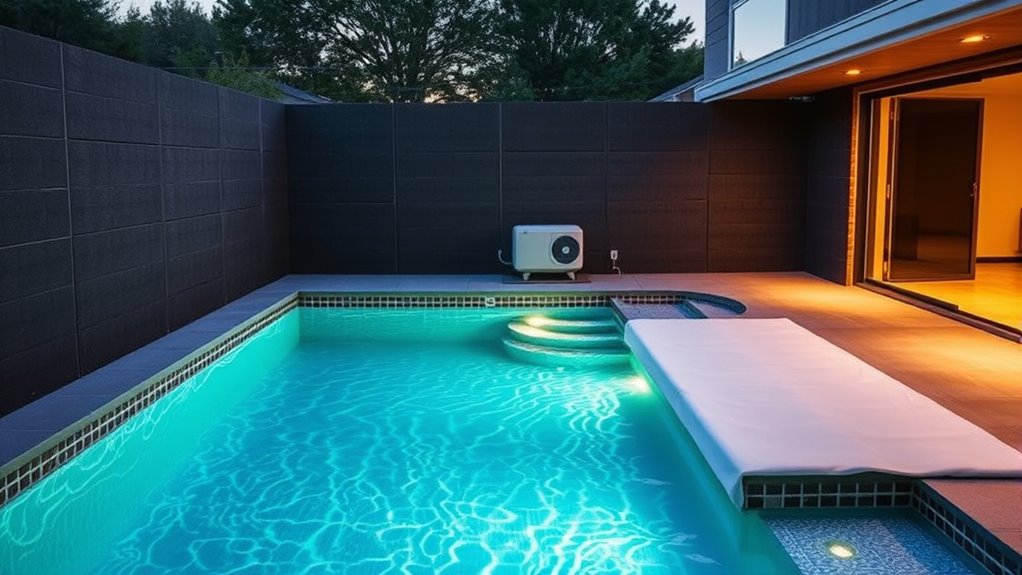
Insulating your pool and equipment area is essential for maintaining an ideal temperature and reducing energy costs. Proper insulation keeps heat in during colder months and prevents heat loss through walls, floors, and ceilings. For your pool, install foam or fiberglass insulation around the shell and beneath the deck to minimize heat transfer. Insulate your equipment area by adding insulation panels or foam to walls and doors, which helps retain heat and reduce the workload on your heater. Seal gaps and cracks to prevent drafts that can cause heat loss. Using reflective barriers can also bounce heat back into the space. These steps ensure your pool stays warm efficiently, cutting down on energy use and lowering your operating expenses. Incorporating energy-efficient practices such as proper insulation significantly enhances overall efficiency.
Regular Maintenance for Peak Efficiency
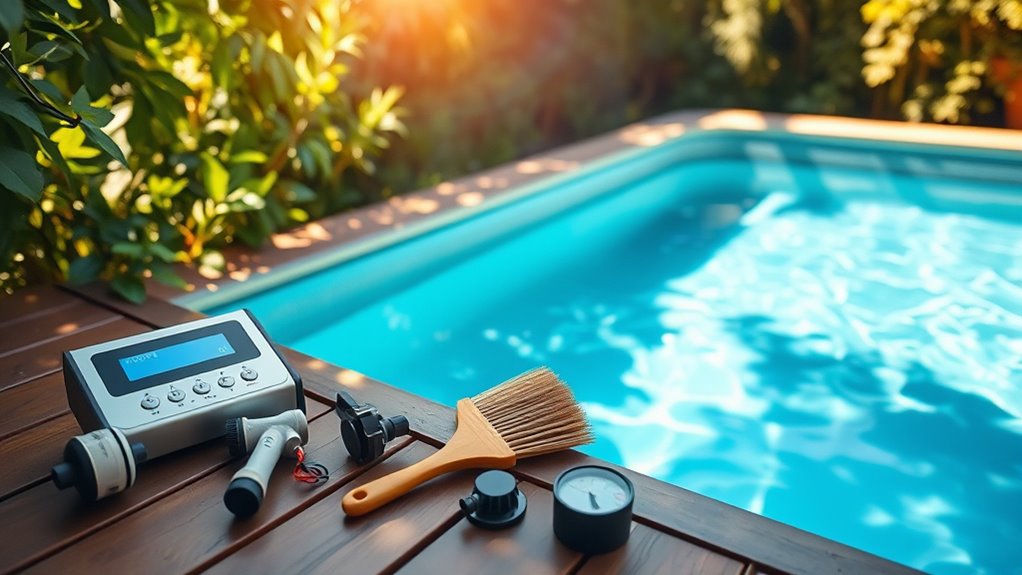
Regular maintenance keeps your pool running efficiently and saves you money. Make sure to clean your pool components frequently to prevent buildup that can strain equipment. Also, inspect and replace filters as needed to maintain ideal flow and energy use. Paying attention to dog breed characteristics can help you better understand and care for your pets, ensuring a happy and healthy environment for everyone.
Clean Pool Components Regularly
Keeping your pool components clean is essential for maintaining peak efficiency and reducing energy costs. When parts like the skimmer, jets, and pump are free of dirt and debris, your system works more smoothly. Regular cleaning prevents buildup that can cause blockages or strain on equipment. To keep things in top shape:
- Remove debris from skimmers and jets weekly.
- Wipe down the pump and filter housing to prevent grime.
- Check for any algae or scale forming on internal surfaces and clean as needed.
- Understanding the history of pinball machines can inspire innovative design features that improve game longevity and performance.
Inspect and Replace Filters
Inspecting and replacing your pool filters regularly is key to maintaining ideal flow and energy efficiency. Dirty or clogged filters force your pump to work harder, increasing energy consumption and wear. Check your filters weekly for dirt, debris, and signs of damage. If you notice reduced water flow or cloudy water, it’s time to clean or replace them. Many filters can be rinsed with a garden hose, but some may need replacement if they’re torn or heavily soiled. Always follow your manufacturer’s guidelines for cleaning intervals and replacement. Keeping filters in top condition ensures proper water circulation, reduces strain on your pump, and lowers operating costs. Regular filter maintenance is a simple step that delivers long-term savings and keeps your pool running smoothly. Proper water circulation is essential for overall pool efficiency and lifespan.
Exploring Alternative Power Options and Solar Solutions

Have you considered how alternative power options and solar solutions can considerably reduce your energy costs? Modern technology offers several ways to power your Endless Pool more efficiently. First, you might install solar panels to harness sunlight and generate electricity, cutting down on grid dependence. Second, exploring wind or small-scale renewable sources, like micro-hydro, can supplement your power needs. Third, using energy-efficient inverters and batteries allows you to store excess solar energy for later use, reducing reliance on traditional power sources. These options not only lower your operating costs but also minimize your environmental impact. By investing in renewable energy solutions, you create a sustainable, cost-effective way to keep your pool running smoothly while saving money over time.
Monitoring Energy Usage With Smart Technology

Ever wonder how you can optimize your energy consumption more effectively? Smart technology makes it simple. With energy monitoring systems, you gain real-time insights into your Endless Pool’s power use. You can identify patterns, spot inefficiencies, and make informed adjustments that save money and reduce environmental impact. Imagine knowing exactly when your pool consumes the most energy, so you can optimize usage during off-peak hours. These systems often come with intuitive apps that let you control and monitor remotely, giving you peace of mind and empowering you to manage costs proactively.
| Energy Use Insights | Emotional Impact |
|---|---|
| Real-time data | Feel confident in your choices |
| Usage patterns | Experience control and peace |
| Cost savings | Enjoy financial relief |
Budgeting and Planning for Long-Term Cost Savings
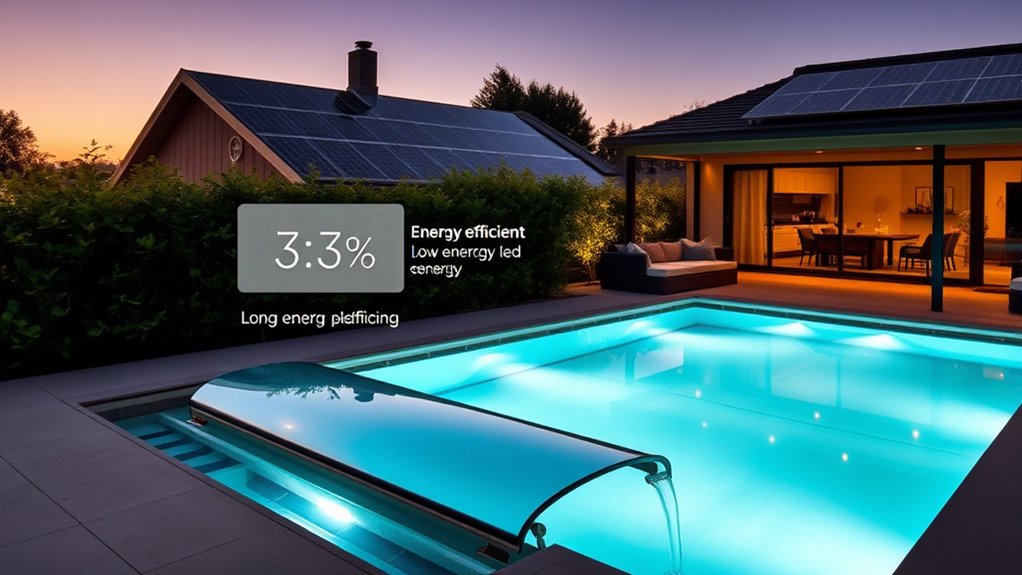
Building on your ability to monitor energy use with smart technology, planning your budget for long-term savings becomes even more effective. Start by setting clear goals for reducing operating costs. Then, focus on these three key steps:
- Estimate future expenses based on current energy consumption and potential improvements.
- Allocate funds for maintenance, upgrades, and energy-efficient equipment over time.
- Track and adjust your budget regularly, using data from smart technology to identify cost-saving opportunities.
Frequently Asked Questions
How Does Pool Size Affect Energy Consumption?
Larger pools generally consume more energy because they require more water to heat, filter, and circulate. You’ll find that bigger pools need higher capacity pumps and heaters, which use more power, increasing your operating costs. To keep energy use efficient, consider minimizing your pool size if space and needs allow, and guarantee your equipment is properly maintained and optimized for your specific pool size.
What Are the Best Practices for Reducing Operating Noise?
Think of your pool like a gentle stream, where quiet flow matters. To reduce noise, guarantee your pump is properly maintained and placed on a sound-absorbing surface. Use vibration pads or mounts to dampen sound. Keep equipment enclosed in soundproof cabinets if possible, and operate pumps during off-peak hours. Regular maintenance prevents noisy vibrations, helping your pool stay peaceful and serene.
Can Automation Systems Improve Energy Efficiency?
Yes, automation systems can improve your pool’s energy efficiency. By automatically adjusting pump speeds, temperature settings, and lighting based on usage and time of day, you reduce unnecessary energy consumption. These systems help you optimize performance without constant manual adjustments, saving you money and energy. With smart automation, you gain control over your pool’s operation, making it more efficient and environmentally friendly while ensuring it remains comfortable and ready whenever you want to swim.
How Often Should Filters Be Serviced for Optimal Savings?
You should service your filters at least every 4 to 6 weeks to keep your pool running smoothly and save on energy costs. Regular cleaning prevents clogs and guarantees the pump isn’t working overtime, which can spike your energy bills. Think of it as giving your pool a tune-up; the less strain on the system, the more money you save. Staying on top of filter maintenance is the key to maximum savings.
What Are the Environmental Benefits of Using Solar Energy?
Using solar energy helps reduce your carbon footprint by cutting greenhouse gas emissions. It’s a renewable resource, so you won’t deplete natural supplies. Solar power also decreases your reliance on fossil fuels, which are harmful to the environment. By switching to solar, you promote cleaner air and conserve water, since solar panels don’t need water to generate energy. Overall, it’s a sustainable choice that benefits the planet and future generations.
Conclusion
By following these tips, you can keep your Endless Pool running efficiently and save on energy costs—no need for a time machine to enjoy savings today. Regular maintenance, smart technology, and simple adjustments make a real difference. Think of it as your own personal quest, like a knight’s journey to efficiency. With a little effort, you’ll enjoy a cozy, cost-effective oasis for years to come, proving that even in modern times, smart choices reign supreme.


